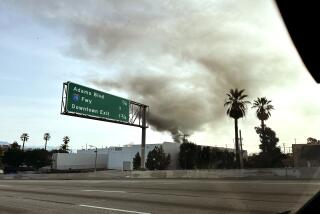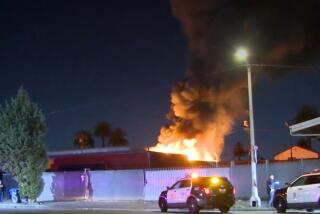Wildfire blamed on pot growers
A fire that has burned more than 87,000 acres in Santa Barbara County was started by an illegal marijuana operation, authorities said, apparently making it the first major wildfire in the state caused by drug traffickers.
The county sheriff’s department, which has recently eradicated other nearby marijuana plots, believes the site was run by a Mexican drug organization, but officials Sunday declined to say how investigators reached that conclusion.
Narcotics agents say hidden marijuana gardens are increasingly being planted in California’s mountainous regions, including its vast national forests. Federal agents say many of these pot farms are tied to Mexican drug cartels that use forest lands to camouflage large operations.
Investigators found that the fast-moving La Brea fire, which was 64% contained Sunday, was sparked by flames from a cooking fire near a remote, overgrown canyon in Los Padres National Forest.
Even as firefighters battled the flames, authorities said those believed to be responsible were probably still in the forest trying to escape by foot. No suspects had been apprehended as of late Sunday, and law enforcement officials warned the public not to approach anyone who looked suspicious and to notify the sheriff’s department.
Santa Barbara County Sheriff’s Department officials would not say whether the suspects were armed. But law enforcement officials with experience eradicating illicit pot operations say that is likely.
U.S. Forest Service Fire Cmdr. Jeanne Pincha-Tulley said the agency’s law enforcement units would be prepared if they came upon the fleeing growers. “I doubt they would come near the firefighters,” she said. “But considering how much we tramp through the woods, it’s kind of scary.”
--
Gaining ground
The La Brea fire is one of at least a dozen being fought as the state heads into the critical late-summer fire season. Firefighters were getting the upper hand on most of the blazes.
Daniel Berlant, a spokesman for the California Department of Forestry and Fire Protection, said four major fires have been burning in Santa Cruz, Shasta, Yuba and Alameda counties. Several smaller fires have broken out in recent days.
The Lockheed fire near Santa Cruz at one point threatened thousands of homes, but firefighters were beginning to make progress on the 6,800-acre blaze, and evacuation orders were lifted Sunday.
Berlant said strong winds in Northern California made it difficult to fight the flames last week, but they have started to subside. “As the winds have let up somewhat, our crews have really been able to take advantage,” he said.
The number of fires is normal for August, Berlant said. Typically, the most damaging fires occur in September and October, as has been the case with a series of devastating wildfires in Southern California in recent years.
Investigators in Santa Barbara County discovered an unburned marijuana patch near where the La Brea fire broke out Aug. 8, investigators with the Forest Service and the Sheriff’s Department said in a joint statement released late Saturday. There was evidence that the site had been occupied within the last several days, and the scene suggested that a cooking fire was the cause of the blaze.
Pincha-Tulley and other fire officials said Sunday that they couldn’t recall another instance where the operators of an illegal marijuana farm had sparked a wildfire.
Authorities declined to provide further information Sunday.
“There’s really nothing I can say beyond our release,” said sheriff’s spokesman Drew Sugars, adding that the department could hold a news conference today to discuss the details.
Marijuana farms might be novel territory to firefighters, but not to forest rangers and narcotics agents.
A Santa Barbara County sheriff’s narcotics unit has been working in the Los Padres forest area over the past month pulling plants from other grow sites.
Forest Service rangers work with state and federal narcotics agents each summer to find and root out large marijuana farms that sprout in a March-to-October growing season, said Vicki Collins, a forest service spokeswoman.
This is the time of year when the biggest plants are found, she said.
“It seems like it’s occurring more and more on national forest lands,” she said.
Ventura County Sheriff’s Sgt. Mike Horne said these growers prefer to use propane to cook because open fires or barbecues send up smoke that can identify their positions. Makeshift camps are often littered with propane tanks.
The growers typically are armed to protect against would-be thieves, said Horne, a 10-year veteran of the narcotics unit who has spent the last few weeks confiscating plants in a different part of Los Padres National Forest.
This summer, agents patrolling the forest confiscated weapons including a .22-caliber rifle, a .36-caliber handgun and an AK-47, Horne said. “I can’t remember a garden where we didn’t find some evidence of weapons,” he said. “They are involved in the drug trade, which is inherently violent.”
--
Eradication efforts
Ventura County’s squad has already pulled 50,000 plants in forest locations and is on track to eradicate another 20,000 before the season’s end, Horne said. That would be a record for the Sheriff’s Department, he said.
Federal and state drug agents last fall eradicated nearly 3 million plants across the state, a record haul that represented a 25% increase over 2006. Seventy percent was found in state and national forests and on other public lands, authorities said.
In recent weeks, narcotics agents have spread out to intercept operations in deeply forested areas across the state.
More than 10,000 plants were pulled from San Bernardino National Forest in early July. A few weeks later, in raids on multiple sites in the Sierra foothills east of Fresno, agents arrested dozens of people, seized 32 weapons and destroyed 400,000 pot plants with an estimated street value of more than $1 billion.
An additional 85,000 plants were pulled in recent weeks from farms in Merced and Shasta counties.
Tightened border security after the Sept. 11, 2001, terrorist attacks made it cheaper for Mexican drug traffickers to send workers north to grow gardens than to smuggle dope across borders, federal and state drug agents have testified.
California, with its favorable weather and good soil, is attractive ground for growing marijuana. Federal agents estimate that half of the nation’s cannabis crop is grown in the state.
--
catherine.saillant@latimes.com
ari.bloomekatz@latimes.com
Times staff writer Carla Rivera contributed to this report.
More to Read
Start your day right
Sign up for Essential California for news, features and recommendations from the L.A. Times and beyond in your inbox six days a week.
You may occasionally receive promotional content from the Los Angeles Times.







